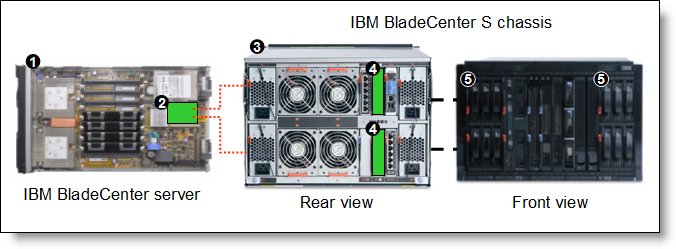Abstract
The SAS Connectivity Card (CFFv) for BladeCenter is an expansion card that offers an ideal way to connect the BladeCenter HS12 and HS21 XM servers to a wide variety of Serial Attached SCSI (SAS) storage devices. Built on proven 3 Gbps, full-duplex SAS technology, the SAS Connectivity Card can connect to the IBM System Storage DS3200 from the BladeCenter E or H chassis and to multiple Disk Storage Modules (DSM) in the BladeCenter S. The card routes the pair of SAS channels from the blade's onboard SAS controller to SAS switches that are installed in the BladeCenter chassis.
Introduction
The SAS Connectivity Card (CFFv) for BladeCenter is an expansion card that offers an ideal way to connect the BladeCenter HS12 and HS21 XM servers to a wide variety of Serial Attached SCSI (SAS) storage devices. Built on proven 3 Gbps, full-duplex SAS technology, the SAS Connectivity Card can connect to the IBM System Storage DS3200 from the BladeCenter E or H chassis and to multiple Disk Storage Modules (DSM) in the BladeCenter S. The card routes the pair of SAS channels from the blade's onboard SAS controller to SAS switches that are installed in the BladeCenter chassis.
The SAS Connectivity Card is installed into the CFFv slot of the supported blade server. It provides connections to SAS modules that are located in bay 3 and bay 4 of the supported BladeCenter chassis. Figure 1 shows the SAS Connectivity Card (CFFv).
Figure 1. SAS Connectivity Card (CFFv) for BladeCenter
Did you know?
When using the SAS Connectivity Card (CFFv) adapter, you can simultaneously use a CFFh adapter to enable more types of I/O when installed in the BladeCenter H or BladeCenter S chassis. The innovative design of the CFFv adapter works with the CFFh adapter to support this combination.
SAS is a point-to-point architecture in which all storage devices connect directly to a SAS port rather than sharing a common bus as traditional SCSI devices do. Point-to-point links increase data throughput and improve the ability to locate and fix disk failures. The SAS architecture solves the parallel SCSI problems of clock skew and signal degradation at higher signaling rates.
Part number information
Table 1 shows the part number to order this card.
Table 1: Part number and feature code for ordering
| Description | Part number | Feature code |
| SAS Connectivity Card (CFFv) for BladeCenter | 43W3974 | 1591 |
The part number includes the following items:
- One SAS Connectivity Card (CFFv) for BladeCenter
- The documentation CD that contains the SAS Connectivity Card (CFFv) for BladeCenter Installation and User’s Guide
- The IBM Important Notices document
Features
SAS Connectivity Card (CFFv) has the following features:
- CFFv form factor
- External connections for the two SAS ports of blade server's onboard LSI 1064 disk storage controller
- Support for two full-duplex SAS ports at 3 Gbps maximum per channel
- Support for SAS, SSP, and SMP protocols
Operating environment
The expansion card is supported in the following environment:
- Temperature: 10° to 35°C (50° to 95°F)
- Relative humidity: 8% to 80%, noncondensing
Supported servers and I/O modules
The SAS Connectivity Card (CFFv) is supported in the BladeCenter servers listed in Table 2.
Table 2. Supported servers
| Expansion card | Part number | |||||||||||||
| SAS Connectivity Card (CFFv) | 43W3974 | Y | N | Y | N | N | N | N | N | N | N | N | N | N |
Figure 2 shows where the CFFv card is installed in a BladeCenter server.

Figure 2. Location on the BladeCenter server planar where the CFFv card is installed (HS12)
See IBM ServerProven at the following address for the latest information about the expansion cards that are supported by each blade server type:
http://ibm.com/servers/eserver/serverproven/compat/us/
Unlike the SAS Expansion Card, the SAS Connectivity Card does not contain a SAS controller. Instead, it uses the unused SAS controller ports from the blade to enable a SAS connection from the blade server to the SAS Connectivity Module and the external SAS storage fabric. The SAS Connectivity Card requires SAS I/O modules to be installed in bay 3 and bay 4 of the BladeCenter chassis.
The Redundant Array of Independent Disks (RAID) functionality is supplied by the onboard SAS controller in the BladeCenter HS12 and HS21 XM server. The following RAID levels are supported by the onboard SAS controller of those servers:
- RAID-0 (Integrated Striping (IS))
- RAID-1 (Integrated Mirroring (IM))
- RAID-1E (Integrated Mirroring Enhanced (IME))
The maximum number of drives supported by an IM volume is two, plus one optional global hot spare. An IME volume supports up to ten hard disk drives (HDDs), plus two optional hot spares. An IS volume supports up to ten HDDs. The IS volume does not support hot spare drives.
Mixing HDDs of different capacities in a single volume is supported. However, the total volume size is aligned with the size of the smallest HDD. Excess space on larger HDDs is not used.
Both SAS and Serial Advanced Technology Attachment (SATA) HDDs are supported, as is intermixing SAS and SATA drives. However, each volume must have hard disks of the same type, either SAS or SATA.
The following combinations of volumes are supported:
- Two IM or IME volumes per blade server
- One IM or IME volume and IS volume per blade server
- Two IS volumes per blade server
The SAS Connectivity Card (CFFv) requires that a supported I/O module is installed in bay 3 (and bay 4 depending on the configuration) of the chassis in which the cards and servers are installed. Table 3 lists the supported I/O modules.
Table 3. I/O modules supported with the SAS Connectivity Card (CFFv)
| I/O module | Part number | |||||
| SAS Connectivity Module | 39Y9195 | Y | Y | Y | Y | Y |
| SAS RAID Controller Module | 43W3584 | Y | N | N | N | N |
Popular configurations
The SAS Connectivity Card (CFFv) can be used in three different configurations.
External DS3200 attachment
Figure 3 shows the supported topology for the SAS Connectivity Card (CFFv) and an IBM System Storage DS3200 storage server connected to the BladeCenter E or BladeCenter H chassis. In this configuration, the RAID functionality is provided by the external DS3200 storage server.

Figure 3. BladeCenter connected to an external IBM System Storage DS3200 storage solution
Table 4 lists the parts that are used in this configuration.
Table 4. Components used when connecting the SAS Connectivity Card (CFFv) to external disk storage
| Diagram reference | Part number / machine type | Description | Quantity |
| Varies | BladeCenter HS12 or HS21 XM | 1 to 14 | |
| 43W3974 | SAS Connectivity Card (CFFv) for BladeCenter | 1 per server | |
| 8677 or 8852 | BladeCenter E or BladeCenter H | 1 | |
| 39Y9195 | BladeCenter SAS Connectivity Module | 2 | |
| 1726-22X | IBM System Storage DS3200 (Dual Controller) | 1 | |
| 1727 | Optional: IBM System Storage EXP3000 (Dual ESM) | 1 to 3 | |
| 39R6536 | DS3000 Partition Expansion License | 1 |
This configuration also requires cabling between the chassis and the storage server and between the storage server and expansion units. (The cable part numbers are not listed in the table.)
Take these considerations into account when planning external SAS-based disk storage server attachments:
- DS3200 is supported for both data storage and boot from SAN when attached to the supported BladeCenter chassis.
- DS3200 Dual Controller version (1726-22X) is the only supported storage server. The DS3200 single-controller version is not supported.
- Each SAS connectivity module must be attached to one of the controllers in the DS3200, but not to both. That is, having redundant paths from a single SAS Connectivity Module to both DS3200 controllers is not supported.
- Up to 48 hot swap 3.5-inch disk drives with an SAS or SATA interface are supported. Up to three EXP3000 expansion units are supported. The intermixing of SAS and SATA drives is supported. However, you cannot use both SAS and SATA drives in the same array.
- The DS3200 can be attached to up to 14 blade servers (one chassis). A Partition Expansion License is required to support more than four host server blades.
- RAID levels 0, 1, 10, 3, 5, and 6 are supported by the DS3200.
- A maximum of 48 drives is supported in a single RAID 0, 1, and 10 array.
- A maximum of 30 drives is supported in a single RAID array for other RAID levels (3, 5, and 6).
- The logical volume size can be greater than 2 TB.
- One SAS host interface per controller is supported. The optional DS3200 SAS 2-port Daughter Card (39R6509, feature code 4836) is not supported in this configuration.
- Optional FlashCopy and VolumeCopy options are available.
BladeCenter S integrated storage: Basic RAID functionality
The configuration shown in Figure 4 connects the onboard SAS RAID controller of support blade servers to the integrated BladeCenter S storage by using the SAS Connectivity Card (CFFv) in each server and IBM SAS Connectivity Modules in the BladeCenter S chassis. In this configuration, the RAID functionality is provided by the RAID controller on the system planar of the blade server.

Figure 4. BladeCenter S with basic RAID functionality
Table 5 lists the components that are used in this configuration.
Table 5. Components used when connecting the HS21 XM or HS12 onboard RAID controller to the integrated BladeCenter S storage
| Diagram reference | Part number / machine type | Description | Quantity |
| Varies | BladeCenter HS12 or HS21 XM server | 1 to 6 | |
| 43W3974 | SAS Connectivity Card (CFFv) for BladeCenter | 1 per server | |
| 8886 | BladeCenter S | 1 | |
| 39Y9195 | BladeCenter SAS Connectivity Module | 1 or 2 | |
| 43W3581 | BladeCenter S 6-DSM | 1 or 2 | |
| Not applicable | Onboard RAID controller | Integrated |
Take these considerations into account when planning BladeCenter S basic local storage implementations:
- Every HS12 and HS21 XM blade requiring integrated storage connectivity must have one SAS Connectivity Card (CFFv) installed.
- At least one BladeCenter S DSM must be installed into the BladeCenter S chassis; a maximum of two DSMs are supported in one chassis. The BladeCenter S does not ship with any DSMs as standard.
- At least one SAS Connectivity Module must be installed into the BladeCenter S chassis. A maximum of two SAS modules is supported for redundancy and high availability purposes.
- Each physical hard disk drive in any DSM can be assigned to the one blade server only, and the blade itself sees this physical disk (or disks) as its own hard disk drives connected by using the SAS Connectivity Card. That is, there are no logical unit numbers (LUNs), storage partitions, and so forth as in shared storage systems. Instead, each blade has its own set of physical disks residing in the DSMs.
- The SAS Connectivity Module controls disk assignments by using zoning-like techniques, which results in the SAS module maintaining single, isolated dedicated paths between physical HDDs and the blade server. Configuration of the HDD assignments is done by the administrator, and the administrator uses predefined templates or creates custom configurations.
- The RAID functionality is supplied by the onboard disk controller in the blade servers. The onboard RAID controller on blade itself supports the following RAID levels:
- RAID-0 (IS)
- RAID-1 (IM)
- RAID-1E (IME)
- The maximum number of drives supported by the IM volume is two plus one optional global hot spare. The IME volume supports up to ten HDDs plus two optional hot spares. The IS volume supports up to ten HDDs. The IS volume does not support hot spare drives.
- When creating a RAID-1 array, span both disk storage modules. This maximizes the availability of data in the event that one of the paths to the disks is lost, because there is only one connection to each disk storage module in case two SAS Connectivity Modules are used.
- Mixing HDDs of different capacities in a single volume is supported. However, the total volume size is aligned with the size of the smallest HDD, and excess space on larger-sized HDDs is not used.
- The following combinations of volumes are supported:
- Two IM or IME volumes per blade server
- One IM or IME volume and IS volume per blade server
- Two IS volumes per blade server
- Each blade with an SAS expansion card has access to its assigned HDDs in both DSMs, even if only one SAS Connectivity module is present. Potentially, all 12 drives in both DSMs can be assigned to a single blade server. However, only 10 HDDs can be used in a single volume. You can create either two volumes to use the capacity of all drives or designate the remaining two drives as hot spares.
- Both SAS and SATA hot swap HDDs are supported. The intermixing of SAS and SATA drives is also supported. However, each volume must have hard disks of the same type, either SAS or SATA.
- External disk storage attachments are not supported.
BladeCenter S integrated storage: Advanced RAID functionality with shared storage
The configuration shown in Figure 5 connects the SAS Connectivity Card (CFFv) installed in each blade server to the integrated BladeCenter S storage by using two BladeCenter S SAS RAID Controller Modules in the BladeCenter S chassis. In this configuration, the RAID functionality is provided by the RAID Controller Modules in the BladeCenter chassis (and not by the RAID controller that is on the blade server's system planar).

Figure 5. BladeCenter S with advanced RAID functionality
Table 6 lists the parts that are used in this configuration.
Table 6. Components used when connecting the SAS Connectivity Card (CFFv) to the integrated BladeCenter S storage with support for shared storage
| Diagram reference | Part number / machine type | Description | Quantity |
| Varies | BladeCenter HS12 or HS21 XM server | 1 to 6 | |
| 43W3974 | SAS Connectivity Card (CFFv) for BladeCenter | 1 per server | |
| 8886 | BladeCenter S | 1 | |
| 43W3584 | BladeCenter S SAS RAID Controller Module | 2 required | |
| 43W3581 | BladeCenter S 6-DSM | 1 or 2 |
Take these considerations into account when planning BladeCenter S advanced shared storage implementations:
- Every HS12 and HS21 XM blade that requires integrated storage connectivity must have one SAS Connectivity Card installed.
- At least one DSM must be installed into the BladeCenter S chassis; a maximum of two DSMs is supported in one chassis. The BladeCenter S does not ship with any DSMs as standard.
- Two SAS RAID Controller Modules must be installed into the BladeCenter S chassis.
- The SAS RAID Controller Module creates storage pools (or arrays), and the RAID level is defined for these storage pools. Logical volumes are created from storage pools. Volumes can be assigned to specific blades or be shared by several blade servers.
- Zoning is supported by the SAS RAID controller module. However, zoning should not be used for regular operations (that is, for purposes other than troubleshooting).
- RAID functionality is supplied by the SAS RAID Controller Modules installed into the BladeCenter S chassis.
- The RAID levels that are supported are 0, 1, 5, and 10.
- The maximum volume size is 2 TB.
- The maximum number of volumes is eight per blade server (for a total of 48 volumes per chassis).
- One volume can be mapped to all six blades in the chassis.
- Mixing HDDs of different capacities in a single volume is supported. However, the total volume size is aligned with the size of the smallest HDD, and excess space on larger-sized HDDs is not used.
- Both SAS and Near-line SAS (NL SAS) hot swap HDDs are supported. The intermixing of SAS and NL SAS drives is also supported. However, each storage pool must have hard disks of the same type, either SAS or NL SAS. SATA drives are not supported by the SAS RAID Controller Module.
- Global hot-spare drives are supported. The drive that is designated as a hot spare should be as large as or larger than other drives in the system.
- Blade boot from a logical volume is supported.
- Path failover is supported with IBM Subsystem Device Driver Device Specific Module (SDD DSM) for Windows and Device Mapper Multipath (DMM) for Red Hat or Novell SUSE Linux.
- Currently, external storage attachments are not supported.
Supported operating systems
The SAS Connectivity Card (CFFv) supports the following operating systems:
- Microsoft Windows Essential Business Server 2008 Premium Edition
- Microsoft Windows Essential Business Server 2008 Standard Edition
- Microsoft Windows Server 2003, Web Edition
- Microsoft Windows Server 2003/2003 R2, Enterprise Edition
- Microsoft Windows Server 2003/2003 R2, Enterprise x64 Edition
- Microsoft Windows Server 2003/2003 R2, Standard Edition
- Microsoft Windows Server 2003/2003 R2, Standard x64 Edition
- Microsoft Windows Server 2008, Datacenter x64 Edition
- Microsoft Windows Server 2008, Datacenter x86 Edition
- Microsoft Windows Server 2008, Enterprise x64 Edition
- Microsoft Windows Server 2008, Enterprise x86 Edition
- Microsoft Windows Server 2008, Standard x64 Edition
- Microsoft Windows Server 2008, Standard x86 Edition
- Microsoft Windows Server 2008, Web x64 Edition
- Microsoft Windows Server 2008, Web x86 Edition
- Microsoft Windows Small Business Server 2008 Premium Edition
- Microsoft Windows Small Business Server 2008 Standard Edition
- NetWare 6.5
- Red Hat Enterprise Linux 4 AS for AMD64/EM64T
- Red Hat Enterprise Linux 4 AS for x86
- Red Hat Enterprise Linux 4 ES for AMD64/EM64T
- Red Hat Enterprise Linux 4 ES for x86
- Red Hat Enterprise Linux 4 WS/HPC for AMD64/EM64T
- Red Hat Enterprise Linux 4 WS/HPC for x86
- Red Hat Enterprise Linux 5 Server Edition
- Red Hat Enterprise Linux 5 Server x64 Edition
- SUSE LINUX Enterprise Server 10 for AMD64/EM64T
- SUSE LINUX Enterprise Server 10 for x86
- SUSE LINUX Enterprise Server 9 for AMD64/EM64T
- SUSE LINUX Enterprise Server 9 for x86
- VMware ESX 3.5
- VMware ESXi 3.5
See IBM ServerProven at the following address for the latest information about the specific versions and service packs that are supported:
http://ibm.com/servers/eserver/serverproven/compat/us/
Select the blade server and then select the expansion card to see the supported operating systems.
Related product families
Product families related to this document are the following:
Trademarks
Lenovo and the Lenovo logo are trademarks or registered trademarks of Lenovo in the United States, other countries, or both. A current list of Lenovo trademarks is available on the Web at https://www.lenovo.com/us/en/legal/copytrade/.
The following terms are trademarks of Lenovo in the United States, other countries, or both:
Lenovo®
BladeCenter®
ServerProven®
The following terms are trademarks of other companies:
Linux® is the trademark of Linus Torvalds in the U.S. and other countries.
Microsoft®, Windows Server®, and Windows® are trademarks of Microsoft Corporation in the United States, other countries, or both.
IBM®, FlashCopy®, and ibm.com® are trademarks of IBM in the United States, other countries, or both.
Other company, product, or service names may be trademarks or service marks of others.
